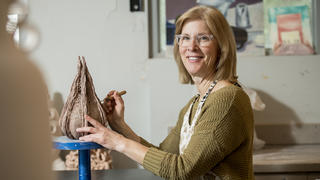A Long Road to the Pottery Wheel
Sue Henry has always been an artist at heart. But the path to her passion hasn’t always been a straight line for the 60-year-old graduating senior.

PHILADELPHIA (April 6, 2017) — Sue Henry has always been an artist at heart. But the path to her passion hasn’t always been a straight line for the 60-year-old graduating senior.
“I worked with clay in high school and took some classes in ceramics at community college,” the Penn Valley, Pennsylvania, native says. “But my parents encouraged me to focus more on science-based studies rather than continuing in art.”
Henry found a talent for the sciences, graduating from Harcum College in 1980 with an associate’s degree in veterinary technology. She next worked alongside researchers at the University of Pennsylvania School of Veterinary Medicine, completed technical training at Thomas Jefferson University Hospital and started a career as a full-time ultrasound technician. Along the way, she got married and had a daughter and twin sons. But despite all her success, she felt a pull for something more.
“Between a full-time job and raising three kids, I wasn’t able to focus on art more than a few hours a week,” Henry says. “So when my sons entered kindergarten, I left my job to stay home, take care of my children, and return to working in clay.”
She quickly re-immersed herself in ceramics, taking classes at local art centers, connecting with fellow artists and selling her work at craft shows. Between her art and family, she felt fulfilled. But another roadblock arose.
“I started feeling extreme pain in my left hand,” Henry recalls. “After consulting with a hand specialist, I was told that I have degenerative osteoarthritis.” She was told that she would not be able to use her hand for ceramics work, a diagnosis that left her feeling defeated.
Henry discussed options for her future with her husband and decided to return to school to finish her bachelor’s degree. She scheduled meetings with several local universities. The first school on her list to meet with was Saint Joseph’s.
“I found the idea of going back to school to be very daunting, but the admissions counselor made me feel more confident and reassured me that what I intended to do was feasible,” she says. She enrolled in the professional and liberal studies major, since it would allow her to transfer the most credits towards a degree.
It wasn’t until her third year at Saint Joseph’s that Henry glanced back at her passion.
“My hands were feeling better and I really missed art, so I decided to sign up for Drawing I,” she says. “My professor — Steve Cope, M.F.A., assistant professor art — was so inspiring. The class filled a void in my life.” The next semester, she enrolled in a ceramic firings class and Drawing II and added an art minor. Before long, the minor became a major.
With guidance from sculptor Jury Smith, M.F.A., assistant professor of art, Henry continued to develop as an artist. “Before my ceramics classes at SJU, I made functional pieces — dishes, bowls, cups, platters and so on,” she says. “Working sculpturally is a totally new experience and one that I am thoroughly enjoying.”
Henry’s work was featured in an exhibition at the Boland Hall gallery during the month of March. The collection, titled “Chromatic Entropy,” was inspired by life cycles seen in nature. The pieces were crafted to convey erosion, withering and desiccation.
“There is obvious beauty in new buds, flowers, and fruit, but what about the involution that occurs after the vibrancy has passed,” she asks. “The seedpod that has since had all of its seeds eaten or carried away, the shrunken berry, or an eroded nutshell. All of these pieces of nature have a beauty of their own, although sometimes more difficult to realize.”
Beyond her art classes, Henry says that returning to school has expanded her thinking.
“Through the diversity of classes I’ve taken, I have gained a broader perspective on life,” she says. “I feel that I have been informed to a point where I can reflect, consider, and react to situations in life that may not always be clear. SJU has broadened my mind and opened my heart.”
Because her art has flourished so much in an academic setting, Henry hopes to continue her studies in graduate school. While she weighs her options, though, she wants to pass the passion on to others.
“I would like to volunteer in places where art education is lacking, especially in Philadelphia public schools,” she says. “One can only hope that art stays in our priorities. I’ve found so much fulfillment this way and I know others will too.”
